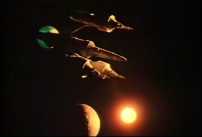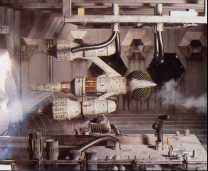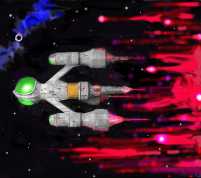The Liberator... Probably the Greatest Spacecraft Ever!
Way back in the festive season of 1977, the
Radio Times proudly announced
the arrival of its new sci-fi drama: Blake's 7. As a loyal and devoted 9
year old fan of Dr Who, I viewed this upcoming series as a rival and
possible replacement for the show I cherished. However, within seconds
of setting eyes on this article, something caught my imagination. It
wasn't the incredibly attractive blonde called Jenna, but the image
above her.
 Spread across two lavishly coloured pages was the breathtaking sight
of what still remains today as the most beautiful looking spacecraft
ever designed. From that moment onwards, I was a loyal B7 fan before the
opening episode had even aired. Like many others, I assumed that the
green power source was the ship's cockpit until the spellbinding episode
Spacefall revealed the ship in her full glory. It was a directional
reversal that added to the Liberator's appeal. No one had simply seen a
ship of this design before.
Spread across two lavishly coloured pages was the breathtaking sight
of what still remains today as the most beautiful looking spacecraft
ever designed. From that moment onwards, I was a loyal B7 fan before the
opening episode had even aired. Like many others, I assumed that the
green power source was the ship's cockpit until the spellbinding episode
Spacefall revealed the ship in her full glory. It was a directional
reversal that added to the Liberator's appeal. No one had simply seen a
ship of this design before.
In a break from tradition, producer David Maloney commissioned the BBC's top
designer Roger Murray-Leach to design both the Liberator's exterior and
interior because Maloney viewed both assignments as one concept. It was a
move that infuriated the special effects department who would normally be
responsible for designing spacecraft exteriors. Ian Scoones, who supervised
all the effects for the 1st season and contributed greatly to some memorable
B7 designs, had already designed the Liberator exterior himself only to find
that Leach's design had been approved at an earlier stage of pre-production.
Scoones' design however was rather functionary (looking uncannily like
season 4's Scorpio) and lacked the visual appeal of Leach's blueprint.
Scoones made a minor adjustment to Leach's final design, which had an oval
power source by replacing it with a more practicable sphere, and he passed on
the design to outside contractors Space Models (who built many of the models
for UFO & Space 1999) based at Feltham. In a interview for
Dreamwatch during the late 80's,
Scoones revealed that he regarded the Liberator as "terribly Eastern,
architecturally," adding "you can tell a set designer has designed it
rather than somebody into spaceships!"
Once Space Models had completed the 3-foot long white model, Scoones then
passed the Liberator onto Martin Bower whom had just two days to add
intricate detail to the ship's hull and weapon pods. Bower added hundreds of
minute pieces of plasticard and panel lines using biro and pencil! He also
added four red oxide blocks around the nose and "Letraline"
Flex-a-Tape to the "engine ball" which broke up the green area.
After having first hand problems in transporting the definitive Liberator
model, Bower and Scoones realised that the model was far too heavy to be
flown on wires because it contained brass, so Bower constructed a slightly
smaller version. Something he later cursed when he realised that he would
have to replicate all the fine and intricate detail he had added to the
original model. Bower also constructed a 20 inch Liberator for long shots
using EMA tubing and Perspex.
 When it came to filming the Liberator, Scoones fears of the "impractical"
design were proved to be right. The physical demands of flying the model are
almost legendary. Scoones feels that the SFX department would have taken this
into account had they designed it. "There are many ways of flying a model so
you don't see the wires, and the Liberator was just a damn difficult thing to
fly, whether it was on wires, poles or whatever else." Some bloopers
involving the definitive Liberator coming of it's pole and crashing to the
floor were shown on The Late, Late Breakfast Show in 1982. More problems were
encountered when the plastic padding that kept the huge model together would
fall off time after time, holding up filming. Bower also found himself having
to replace the green power source of the 3-foot Liberator that melted from
the heat of the bulb that had accidentally been left on during shooting
breaks. Despite problems and reservations about the definitive Liberator
model, Ian Scoones went on to produce some of the finest model work for the
entire series. Most of season one's budget was spent within the first three
episodes at Bray Studios, using talented effects maestro Nick Allder who went
on to win an Oscar for his model work on the classic Alien film. Scoones also
filmed several "beauty shots" of the Liberator that were used as stock
footage including the superb sequence of the ship flying past a amber sun and
two planets. Many more sequences were filmed involving the Liberator at Bray
studios but amazingly, most were never used! Despite some high quality
footage filmed by Scoones, he found that most directors would not accept it.
Scoones revealed that directors were in constant competition with each other,
and that they would shoot their own footage rather than use the ready filmed
stock effects. This led to inferior model sequences that were badly lit and
filmed by in-house BBC cameramen who had never worked with minatures. Many of
these hastily filmed and under funded sequences also made the mistake of
using the smaller Liberator models that were not built for close-up shots.
When it came to filming the Liberator, Scoones fears of the "impractical"
design were proved to be right. The physical demands of flying the model are
almost legendary. Scoones feels that the SFX department would have taken this
into account had they designed it. "There are many ways of flying a model so
you don't see the wires, and the Liberator was just a damn difficult thing to
fly, whether it was on wires, poles or whatever else." Some bloopers
involving the definitive Liberator coming of it's pole and crashing to the
floor were shown on The Late, Late Breakfast Show in 1982. More problems were
encountered when the plastic padding that kept the huge model together would
fall off time after time, holding up filming. Bower also found himself having
to replace the green power source of the 3-foot Liberator that melted from
the heat of the bulb that had accidentally been left on during shooting
breaks. Despite problems and reservations about the definitive Liberator
model, Ian Scoones went on to produce some of the finest model work for the
entire series. Most of season one's budget was spent within the first three
episodes at Bray Studios, using talented effects maestro Nick Allder who went
on to win an Oscar for his model work on the classic Alien film. Scoones also
filmed several "beauty shots" of the Liberator that were used as stock
footage including the superb sequence of the ship flying past a amber sun and
two planets. Many more sequences were filmed involving the Liberator at Bray
studios but amazingly, most were never used! Despite some high quality
footage filmed by Scoones, he found that most directors would not accept it.
Scoones revealed that directors were in constant competition with each other,
and that they would shoot their own footage rather than use the ready filmed
stock effects. This led to inferior model sequences that were badly lit and
filmed by in-house BBC cameramen who had never worked with minatures. Many of
these hastily filmed and under funded sequences also made the mistake of
using the smaller Liberator models that were not built for close-up shots.
Despite all the problems encountered by the SFX department. The Liberator
soon became a favourite with the show's growing army of fans. The exotic
exterior combined with the stylish flight deck could not have been better for
a cash starved budget. With the added touch of the ship's almost human
computer Zen, many began to regard the Liberator as a character in her own
right.
During breaks in filming, the model was actually taken apart like a jigsaw
and placed in a box, which meant that a lot of time was spent assembling the
model for future shots. In the end, this became too time consuming and the
model was sadly neglected later in the show's run in favour of the less
detailed minitures.
 The definitive Liberator's final appearance was in the episode
Ultraworld, where the ship is trapped within an artificial world. It's
an impressive effect sequence where you get to appreciate the 3-foot
model in her full glory.
The definitive Liberator's final appearance was in the episode
Ultraworld, where the ship is trapped within an artificial world. It's
an impressive effect sequence where you get to appreciate the 3-foot
model in her full glory.
A few episodes later, Blake's 7 became the first sci-fi series to treat
the destruction of a glorious spacecraft as the death of a beloved
character.
The Liberator's demise was emotional viewing when Terminal
first aired back in March 1980, and it was a fitting and spectacular end to
this unique concept.
To have the "indestructible" Liberator slowly disintegrate from a cancerous
and mysterious phenomenon encountered in deep space was inspired writing on
the part of the great Terry Nation. It was a fitting end to an incredible
idea that was years ahead of its time.
Many will recall with fondness, the wonderful little Corgi minitures that
were released in 1979. I wish I still had one! Thanks though to Comet
Minatures who released a labour of love in the form of the definitive
Liberator model kit in 1989.
In the Aftermath, the Liberator's legacy lives on. Ron Thornton, who built
the Scorpio model, later found work pioneering the Emmy award winning CGI
effects for Babylon 5. Together with
the show's creator (and fellow B7 fan), J. M.
Straczynski, they decided to pay homage to the Liberator by basing the
Drazi War ship on this much loved DSV that first appeared in the B5
episode Matters of Honor from season 3.
Straczynski's new B5 spin-off Crusade
also features a ship called the Excalibur which can almost be described as a
DSV 2 and is the closest we may ever get to a CGI Liberator.
Despite being "destroyed" twice during the run of the series, the definitive
Liberator still thankfully exists. According to an article dated January 1997
in The Daily Mirror, the three-foot
model was auctioned off and sold for £3000. A bargain for a piece of TV
history!
This article is dedicated to Roger Murray-Leach, Ian Scoones & Martin
Bower
Rob Windle
Related Links
Episode Review Index
Back up to Essay index
Back up to Blakes 7
Last changed on 17th of December 2000
 Spread across two lavishly coloured pages was the breathtaking sight
of what still remains today as the most beautiful looking spacecraft
ever designed. From that moment onwards, I was a loyal B7 fan before the
opening episode had even aired. Like many others, I assumed that the
green power source was the ship's cockpit until the spellbinding episode
Spacefall revealed the ship in her full glory. It was a directional
reversal that added to the Liberator's appeal. No one had simply seen a
ship of this design before.
Spread across two lavishly coloured pages was the breathtaking sight
of what still remains today as the most beautiful looking spacecraft
ever designed. From that moment onwards, I was a loyal B7 fan before the
opening episode had even aired. Like many others, I assumed that the
green power source was the ship's cockpit until the spellbinding episode
Spacefall revealed the ship in her full glory. It was a directional
reversal that added to the Liberator's appeal. No one had simply seen a
ship of this design before.
